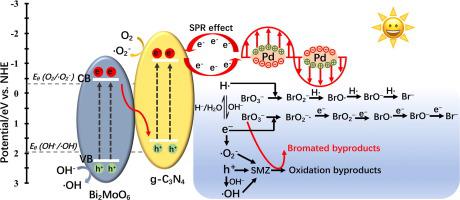Chemical Engineering Journal ( IF 13.3 ) Pub Date : 2020-06-29 , DOI: 10.1016/j.cej.2020.126061 Guanglan Di , Zhiliang Zhu , Hua Zhang , Yanling Qiu , Daqiang Yin , John Crittenden

|
The electron mediator is a feasible tool to promote electron-hole separation and transfer in Z-scheme photocatalysts, offering a promising opportunity to enhance the redox capacity. Pd-mediated Z-scheme Bi2MoO6/g-C3N4 (Pd/Bi2MoO6/g-C3N4) were synthesized for simultaneously oxidizing sulfamethazine (SMZ) and reducing BrO3– under LED-simulated daylight (380 ≤ λ ≤ 780 nm). Pd/Bi2MoO6/g-C3N4 exhibited higher photoactivities as compared to Bi2MoO6/g-C3N4, which was attributed to the favorable interfacial charge transfer induced by Pd electron mediator. Enhanced removal kinetics of SMZ and BrO3– were observed in the binary system compared to those achieved when only one contaminant was present. Synergetic mechanisms were proposed as follows: i) simultaneous SMZ oxidation by holes and BrO3– reduction by electrons resulted in less charge recombination and more efficient consumption of reactive species (RSs), ii) BrO3– played multiple roles in SMZ oxidation, altering the RSs speciation and forming bromine radicals, which not only accelerated the SMZ oxidation but formed bromated byproducts. Pathways for simultaneous removal of SMZ and BrO3– were proposed based on the formed byproducts and Br mass balance. The practical potential of Pd/Bi2MoO6/g-C3N4 for simultaneously removing SMZ and BrO3– was investigated in actual water matrixes. After treating for 10 h, no SMZ was detected and the residual BrO3– was below 10 μg·L–1. This work provides an illustrative strategy for the applications of noble-metal mediated Z-scheme photocatalysts in water treatment by simultaneous oxidation and reduction, taking advantages of the oxidative and reductive RSs generated during photocatalytic process.
中文翻译:

Pd介导的Z方案Bi 2 MoO 6 / gC 3 N 4光催化剂同时使磺胺二甲嘧啶氧化和溴酸盐还原:协同机理和降解途径
电子介体是促进Z方案光催化剂中电子-空穴分离和转移的可行工具,为增强氧化还原能力提供了有希望的机会。合成了Pd介导的Z方案Bi 2 MoO 6 / gC 3 N 4(Pd / Bi 2 MoO 6 / gC 3 N 4),用于在LED模拟日光下(380≤380)同时氧化磺胺二甲嘧啶(SMZ)和还原BrO 3 。 λ≤780 nm)。为Pd / Bi 2的MoO 6 / GC 3 Ñ 4相比,铋表现出更高的photoactivities 2的MoO 6/ gC 3 N 4,这归因于Pd电子介体诱导的有利的界面电荷转移。SMZ和的BrO的增强去除动力学3 -在二进制系统中观察到的那些相比当只有一种污染物存在来实现的。协同机制提出了如下:通过孔ⅰ)同时SMZ氧化的BrO 3 -还原由电子导致更少的电荷的重组和反应性物质(RSS)的更有效的消耗,ⅱ)的BrO 3 -在SMZ氧化中起多种作用,改变RS的形态并形成溴自由基,这不仅加速了SMZ氧化,还形成了溴化副产物。同时去除SMZ和的BrO的途径3 -均提出了一种基于所形成的副产物和Br质量平衡。的Pd / Bi的实际潜力2的MoO 6 / GC 3 Ñ 4用于同时去除SMZ和的BrO 3 -中的实际水矩阵进行了研究。处理10小时后,未检测到SMZ,且残留的BrO 3 –低于10μg·L –1。这项工作为利用贵金属介导的Z型光催化剂通过同时进行氧化和还原而在水处理中的应用提供了说明性策略,并利用了光催化过程中产生的氧化和还原RS的优势。











































 京公网安备 11010802027423号
京公网安备 11010802027423号